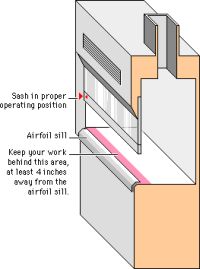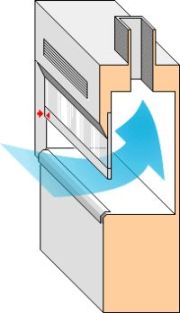| Page 2 |

|
|
1 - Ventilation Equipments
2 - Page 2 3 - Page 3 4 - Page 4 |

 HOME
HOME |
![]() Laboratory Fumehood in Quicktime Movie
Laboratory Fumehood in Quicktime Movie
RunningTime: 11 minutes
 |
Chemical fume hoods capture, contain, and expel emissions generated by hazardous chemicals.
In working with hazardous chemicals, the release of emissions cannot always be controlled; therefore, the fume hood offers an extra measure of protection.
In general it is a good idea to conduct all laboratory experiments in a fume hood.
The location of the fume hood affects its efficiency. Ideally, fume hoods should be located in an area of minimal traffic. When a person walks by a fume hood, turbulence can be created causing contaminants to be drawn outside the hood. The air flow into the room has an effect on the fume hood. All doors should be closed to maintain the negative pressure of the lab with respect to the corridor. This ensures that any contaminants in the lab will be exhausted through the fume hood and not escape into the hallway.
Baffles
The baffles are movable panels located on the back wall of the hood that create slots in which air is exhausted. The pattern of the air moving into and through the hood is determined by the setting of the baffles.
 |
Sash
Sash is the term used to describe the movable glass panel that covers the face area of a fume hood. Many hoods are installed with a sash stop, which stops the sash at approximately a 14 inch work level. It is recommended that all lab work in a properly functioning fume hood be performed at the sash stop level or lower whenever possible.
Velocity
Face velocity is a measurement of the average velocity at which air is drawn through the face to the hood exhaust. The acceptable range of the average face velocity is 60-100 feet per minute (fpm) at working sash height 14 - 18 inches.
 |
If non-carcinogenic materials are being used the acceptable face velocity for minimally hazardous materials is 50 fpm.
If using a carcinogen, reproductive toxin, or acutely toxic material it is recommended that the face velocity range from 60 to 125 fpm. At velocities greater than 125 fpm, studies have demonstrated that the creation of turbulence causes contaminants to flow out of the hood and into the user's breathing zone.
Small pieces of tinsel are taped to the bottom corner of the sash. Inward movement of the tinsel indicates air is being drawn into the hood. Air flow indicators do not determine face velocity. They only indicate that air is being exhausted through the fume hood.
| << Previous 1 [2] 3 4 Next >> |
